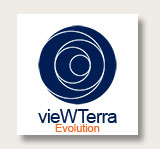vieWTerra Evolution 4D real-time Earth Viewer: More detailed Features
• Advanced real-time LOD system:
Real-time creation of geometry and textures, offering real-time
modification of the following parameters:
- Terrain geometry
- Texture mapping
- Shadows
- 3D Objects
• Advanced real-time Dynamic Weather System (DWS):
Real-time simulation of weather conditions, offering real-time modification of the following parameters:
- Wind speed / direction (impacting clouds, sea states, vegetation, 3D objects like windmills or flags)
- Cloud cover
- Temperature
- Snow cover (variable snow mantle)
- Precipitations (rain or snow depending on temperature)
- Range (all weather parameters applied to a given area, extending or decreasing
in a circle)
- Visibility (changeable field of view, with more of less haze/fog in the distance)
• Procedural creation of textures:
Textures are procedurally-created in real-time according to the nature of the ground and the degree of slope, so as to place the right type of ground cover (sand, pebbles, rocks, salt, snow, vegetation...) at the right location, based on Land Cover databases.
• Procedural creation and rendering of vegetation (DVR):
Vegetation models are procedurally created and rendered in real-time.
Distribution of flora is automatically done according to the nature of the ground and the type of climate, based on Land Cover and Ecoregions databases: 20 different tree models are being provided by default as an example of integration; additional models can be easily added via the Editor Tool.
Planting or removing specific trees or customizing the nature of the ground (grass/rocks/sand...) can be done very quickly and easily via the Editor Tool or for more global changes via the vieWTerra Evolution SDK/Library.
• Dynamic management of natural and artificial lights:
- Dynamic management of natural light:
24-hour day/night cycle, including real-time management of shadows on terrain (ray-casting) and objects, taking into account reflection and refraction to light for each material used (water/snow, wood/metal, etc), sunrise/sunset scattering , lens flare effect when facing the Sun, variable Sun reflection in the water, moonlight more visible under full moon, etc.
- Dynamic management of artificial lights (automatic lighting of houses, streets or runways, projector beams, moving vehicle lights, animated lighthouse beam at dusk etc ; user control of lighting possible via the vieWTerra Evolution SDK/Library)
• Dynamic management of ALFs (Autonomous Life Forms):
Automatic management of Autonomous Life Forms based on a cyclical time parameter:
- display of moving 3D objects with a random behaviour, for instance vehicles, pedestrians, animals, to quickly and conveniently populate scenes without having to program each entity's behaviour (parameterizable via the vieWTerra Evolution SDK/Library)
- billions of moving animals already implemented ; distribution of fauna according to Ecoregions databases (about a hundred different species are provided, as an example of integration).
• Dynamic 3D sea management:
Increase or decrease the sea level, adjust the water transparency to your needs, adapt the level of sun reflection on the water. Change the water colour, activate/deactivate shaders, activate/deactivate cloud reflection on the water, activate/deactivate the use of water textures, and change wave patterns.
• User-controllable dynamic entities:
vieWTerra Evolution includes several types of user-controllable entities/transportation means users can choose from the Entity Menu, and control by using various keyboard keys:
- Human/avatar
- Parachute
- Glider
- Snowbike
- Car
- Boat
- Bathyscaphe
- Balloon
- Helicopter
- Aircraft
- Rocket
- Space shuttle
- Satellite...
Depending on the type of entities chosen, users can incarnate them, navigate them in 1st person mode or view them in 3rd person perspective, from any possible camera angle around the entity, with a total freedom of movement. These entities are provided with basic dynamics and accompanied by metadata, which users may enhance/replace by more detailed/accurate ones thanks to the vieWTerra Evolution SDK/Library. Users may also introduce their own set of controllable entities in the Entity Tool and control them themselves, or use CSV trajectory files, or put in place a UDP protocol in order to retrieve the positions of real-life moving assets on-the-fly.
The vieWTerra Evolution Viewer also displays various information and offers
Data integration, Editing and GIS Tools (please see the Tools section).
vieWTerra Evolution also includes a Simulation of the global air traffic around the World (20,000 aircrafts following virtual flight routes at a given T Time) and offers the following Navigation modes and additional controls through various 2D interfaces:
• through the 2D Global Map of the Earth:
- by clicking anywhere on the planisphere
- by entering a name in the Name search Menu and clicking on a given name:
vieWTerra Evolution includes a database of 5 million+ georeferenced place names (continents, countries, states, cities, villages, rivers, lakes, seas, capes, mountain chains, peaks, national and regional parks, deserts, landmarks…)
- by entering latitude and longitude coordinates
• through the Screenshots Album:
- by clicking on a given screenshot: this allows to conveniently share viewpoints between different users. Each screenshot registered in the album contains information as to the specific conditions under which is has been taken: time of year, time of day, location, weather conditions, camera angle. This facilitates navigation, cooperative scenario creation and video recording.
• through the 2D Compass:
- by clicking anywhere in the 2D compass.
Users can choose between three visual modes displayed by the compass: DEM, Imagery or Land Cover and zoom in/zoom out of the compass. When pointing anywhere into the compass users get additional information as to the targeted location or the moving entity's accurate lat lon coordinates and location (country), the accurate distance between two points or the distance between the targeted entity and the user's location. For a quick appraisal of all moving entities in the area represented in the compass, these are visible and labeled and can be reached directly in the 3D Window from the Compass.
• Extra-terrestrial navigation
Leave the Earth and visit the Moon or Mars. Extra-terrestrial navigation is enhanced with instant travel mode to the represented astronomical bodies.


